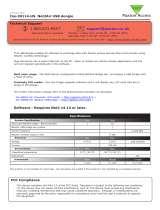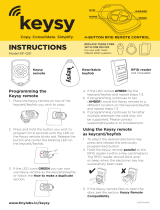Paxton Proximity LR reader User guide
- Category
- Security access control systems
- Type
- User guide
This manual is also suitable for
Paxton Proximity LR reader
The Paxton Proximity LR reader is a long-range reader that can read Paxton hands-free tokens up to a maximum of 5 meters. The system comprises a long-range reader with an integral hands-free interface and hands-free tokens (keycard or keyfob).
The system operates by using the field being transmitted by the reader to wake up the token, which then communicates with the interface.
Existing Switch2 or Net2 control units can be used without modification. Standard Paxton tokens/keyfobs can be used with this reader but at their normal read range.
Hands-free tokens also include a standard proximity ID chip; therefore, they can be presented to any Paxton proximity reader whether they are using the hands-free interface or not.
Paxton Proximity LR reader
The Paxton Proximity LR reader is a long-range reader that can read Paxton hands-free tokens up to a maximum of 5 meters. The system comprises a long-range reader with an integral hands-free interface and hands-free tokens (keycard or keyfob).
The system operates by using the field being transmitted by the reader to wake up the token, which then communicates with the interface.
Existing Switch2 or Net2 control units can be used without modification. Standard Paxton tokens/keyfobs can be used with this reader but at their normal read range.
Hands-free tokens also include a standard proximity ID chip; therefore, they can be presented to any Paxton proximity reader whether they are using the hands-free interface or not.






-
 1
1
-
 2
2
-
 3
3
-
 4
4
-
 5
5
-
 6
6
Paxton Proximity LR reader User guide
- Category
- Security access control systems
- Type
- User guide
- This manual is also suitable for
Paxton Proximity LR reader
The Paxton Proximity LR reader is a long-range reader that can read Paxton hands-free tokens up to a maximum of 5 meters. The system comprises a long-range reader with an integral hands-free interface and hands-free tokens (keycard or keyfob).
The system operates by using the field being transmitted by the reader to wake up the token, which then communicates with the interface.
Existing Switch2 or Net2 control units can be used without modification. Standard Paxton tokens/keyfobs can be used with this reader but at their normal read range.
Hands-free tokens also include a standard proximity ID chip; therefore, they can be presented to any Paxton proximity reader whether they are using the hands-free interface or not.
Ask a question and I''ll find the answer in the document
Finding information in a document is now easier with AI
Related papers
-
Paxton 313-110-US Specification
-
Paxton ins-30099 Operating instructions
-
Paxton Proximity Hands free Interface Specification
-
Paxton OEM Hands free interface, Clock & Data output Quick start guide
-
Paxton Net2 Evaluation Kit User guide
-
Paxton Hands Free Demonstration Unit User guide
-
Paxton OEM PROXIMITY Long range reader - EM4100 - Wiegand Output User guide
-
Paxton Net2 desktop reader, USB Specification
-
Paxton ins-30081 Operating instructions
-
Paxton OEM hands free interface User guide
Other documents
-
ELTRA 2145711C User manual
-
 Paxton Access USE380592 User manual
Paxton Access USE380592 User manual
-
 keysy KF-001 Operating instructions
keysy KF-001 Operating instructions
-
Blaupunkt Frankfurt C70 User manual
-
Blaupunkt Mnchen RDM 169 User manual
-
Blaupunkt Woodstock DAB54 Owner's manual
-
Blaupunkt CD70 User manual
-
ACO Familio PRO Operating Instructions Manual
-
Blaupunkt CD72 User manual
-
Blaupunkt PHOENIX CD70 User manual







